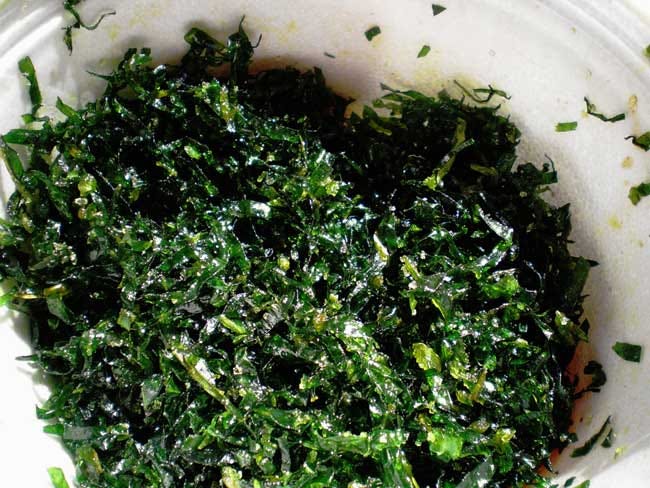When I lived on the Isle of Mull (top left hand side of Scotland), I’d take the midge-clouded path to Rubha nan Gall Lighthouse just north of Tobermory, the island’s main town, through a hazel glade so muddy year round that plastic crates were set to act as stepping stones.
Built in 1857 by David and Thomas Stevenson of the family of builders which over the generations built most of Scotland’s lighthouses, the name in Gaelic means ‘Stranger’s Point’. When it became automated in 1960, the lighthouse keepers who had lived in two cottages nestled into the cliff left, and they became dilapidated. (Now restored, one forms a private home, the other a cottage you should rent).
I would go down to the clear, clean water and gather one of the many varieties of kelp to turn into toasted sesame seed-sprinkled Japanese salad to eat with hand-dived scallops from Guy Grieve.
Kelp used to be an important industry in Scotland. Kelp ash was used in the manufacture of soap and glass. In 1750, one ton of Scottish kelp fetched £3 (now only $3.60 depending on what the Bank of England and the British government are playing at on any given day). By 1810, with the price rising to £20, more and more communities around the coast turned to kelp production. At the industry’s height, 10,000 families across the country were involved in it. Then following the Battle of Waterloo in 1815, duty on imports from the Continent were lifted and prices collapsed. (Hello? British Government: anyone there?) The end of the kelp industry was a contributor to Scottish emigration.
But the industry may be on its way back. A good source of sodium, potassium and iodine, kelp or seaweed, has both health and culinary benefits. Oceanium, a Scottish start-up, is developing high-fibre seaweed for use in plant-based meat, gluten-free breads and drinks.
The natural benefit it offers is as a vital water-retention element. Oceanium hopes it will be a replacement for methylcellulose. This synthetic ingredient is already depended upon by major plant-based meat sellers including the highly successful Impossible Foods and Beyond Meat to boost their burgers’ juiciness and binding properties. But methylcellulose has drawn a bad press for various potential side effects. Also, kelp has a really nice taste.
The market for meat replacement is on the increase. Sustainability is cited. The welfare of the planet is cited. Consumer fears for the future is a worthy concern that underpins manufacturers’ drive to produce creations that satisfy consumer guilt. But ‘replacement’ is only a viable market in the developed world. It’s unlikely that substituting plant-based meats for real meats or plant-based anything for real plants holds much interest for inhabitants of parts of the globe whose meat sources and plants supply are repeatedly devastated by drought, flooding, landslides and subsidence, and who must wonder why any more than that very first COP of 1995 was necessary if the developed world truly cared about them or the planet. They must wonder, too, why we are more preoccupied with creating substitutes for foods and dishes and nosh options that probably didn’t exist before World War II than in sustaining farming traditions that could, if properly supported, provide us all with sound nutrition.
I loved sitting out overlooking the Sound of Mull with my nightly wee dram of Tobermory’s Ledaig whisky (Ledaig is pronounced ‘Laychuck’, of course, as I’m sure you will know), munching Crispy Chinese Seaweed. It’s unlikely you’re anywhere near a kelp field. But as any Chinese restaurant chef will tell you, the last thing you need to make Crispy Seaweed is seaweed. It’s made with thinly sliced kale.
1 kg/2 lbs curly kale
1 teaspoon salt
½-1 teaspoon Chinese 5-spice powder
2 teaspoon light brown sugar
vegetable oil for deep frying
Mix the salt, sugar and 5-spice powder together in a small bowl.
Remove the stalks from the kale and discard (or save to stir-fry with garlic, chili, soy sauce and a splash of chicken stock or water).
Wash and thoroughly dry the kale.
Lay the leaves on top of each other and finely shred in batches.
Heat enough oil in a wok until smoking to deep fry the kale.
Add the kale in batches and cook quickly until crispy.
As soon as the strips crisp, remove them with a slotted spoon to a sieve then to kitchen towels to drain.
Cool and sprinkle with the salt, sugar and 5-spice mix then serve in a bowl.







I doubt that corporations can make much money off of real foods or sustainable farming, so those of us living in the privileged world are going to be stuck with hearing all about substitute foods ad nauseam. Let them talk. I don't believe these businesses are interested in anything but their own gain.
Rubha nan Gall - that brings back memories! I worked on a dive boat on the west coast for a season as cook/deckhand, also did a trip there with the RNXS (Royal Naval Auxiliary Service). It spoiled me for shop-bought scallops, ours were still twitching when they hit the pan! Very tasty with a bit of Chinese 5-spice ...